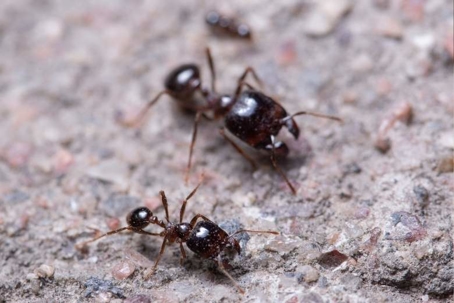What Can Bigheaded Ants Eat?
Bigheaded ants have a surprisingly flexible diet, which is one of the reasons these ants establish such large, persistent colonies. Their feeding habits allow them to survive in a wide range of environments and take advantage of whatever food sources are available.
They’re heavily attracted to sweets, including honeydew produced by aphids, mealybugs, and other sap-feeding insects. This sugary secretion is one of their favorite food sources and plays a major role in why they “farm” or protect these pests on plants. They also consume proteins, such as dead insects, small arthropods, and scraps of meat or pet food left around homes. Indoors, they’ll readily exploit crumbs, grease, sweets, and anything that offers calories with minimal effort. Outdoors, they forage for seeds, plant juices, and organic matter in soil, mulch, and leaf litter.
Their diet is highly opportunistic: if it’s edible and accessible, bigheaded ants will take it. This adaptability fuels their explosive colony growth and makes infestations persistent unless properly controlled.
What Do Bigheaded Ants Eat?
Bigheaded ants most commonly prefer sugary substances, and their top choice is usually honeydew from aphids, mealybugs, and other plant-feeding insects. This sweet, energy-rich food source supports their large colonies and is abundant anywhere these insects are present. After sugars, they frequently go after proteins, especially dead insects or other small arthropods they find while foraging. Around homes, this preference translates into strong attraction to sweets, greasy foods, and protein-rich crumbs or residues. Their consistent focus on sugars and proteins is what drives much of their foraging behavior and helps them thrive in both outdoor and indoor environments.
Do Bigheaded Ants Eat Insects?
Bigheaded ants are opportunistic scavengers, so they’ll eat a wide range of small insects, but they’re most likely to target soft-bodied or already weakened arthropods. Their primary insect meals are usually dead or dying insects they encounter while foraging—things like small flies, gnats, and other ants. They also readily consume parts of larger insects that have already been killed by something else. Because they aren’t strong predators, they typically don’t hunt healthy, fast-moving insects; instead, they scavenge whatever protein sources are easy to collect. Outdoors, they’ll pick apart termites, beetle larvae, small caterpillars, springtails, and other ground-dwelling insects when the opportunity arises. Their willingness to clean up virtually any insect carcass is a major reason they’re able to sustain such large colonies.
Do Bigheaded Ants Eat Animals?
Bigheaded ants don’t actively hunt or feed on animals in the way predators do, but they will consume small animal matter when it’s available. Their feeding behavior is mainly scavenging, so if they come across the remains of tiny animals—such as dead lizards, small frogs, or other creatures that happen to die in their foraging area—they’ll break down the soft tissues for protein. They aren’t capable of killing healthy vertebrates or larger animals, and this type of feeding is opportunistic rather than a regular part of their diet. Their primary focus is still sugars and small insects, but any accessible animal-based protein can become a food source if conditions allow.
Do Bigheaded Ants Eat Plants?
Bigheaded ants don’t typically feed on plants the way plant-eating insects do, but they will use plant-based materials when the opportunity is right. Their main plant-related food source is honeydew, which comes from sap-feeding insects living on plants—so these ants aren’t eating the plants directly, but they depend on those plant pests for sugary secretions. Beyond that, they may consume seeds, especially small ones with nutritious outer coatings, and they sometimes take in plant juices from damaged or decaying vegetation. In mulch, leaf litter, and soil, they’ll also use decomposing organic material as a supplemental food source. Overall, their relationship with plants is indirect and opportunistic rather than true plant feeding, with honeydew being by far the most important plant-associated resource they rely on.

